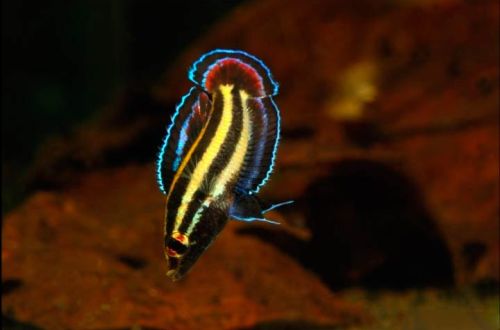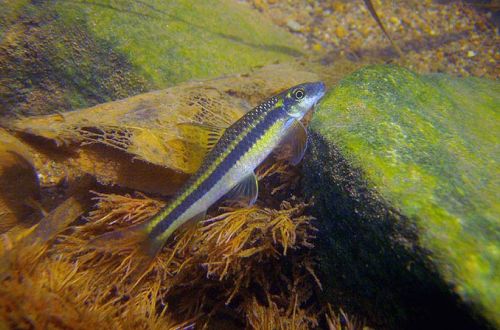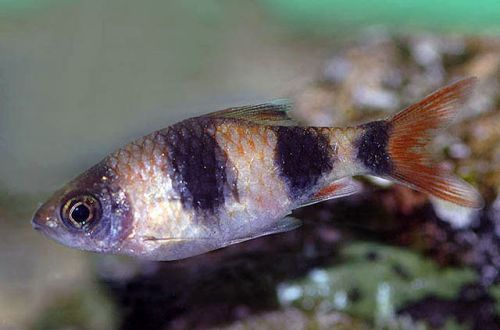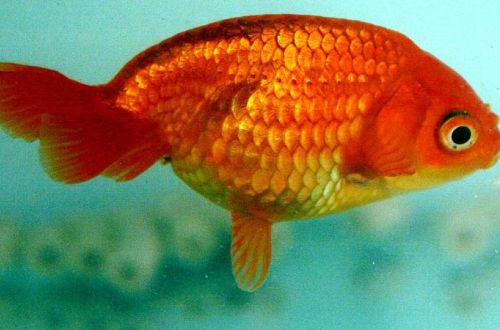
Parosfromenus Alfreda
Parosphromenus Alfreda or Kupanus Alfreda, scientific name Parosphromenus alfredi, belongs to the Osphronemidae family. The fish is named after the former director of the National Museum of Singapore, Eric Alfred, who made a huge contribution to the study of Malay fish. These miniature colorful fish, the last epithet refers only to males, are very demanding to maintain and cannot be combined with most other larger species. Not recommended for beginner aquarists.

Contents
Habitat
It comes from Southeast Asia from the southern tip of the Malay Peninsula, from the territory of the state of Johor, Malaysia and the city-state of Singapore. Almost the entire natural habitat has undergone strong changes in the form of human economic activity by now. Deforestation has led to the degradation of water systems and the extinction of native animal species. Initially, the fish inhabited tropical peat swamps, located in the middle of a dense rainforest. A typical biotope was a shallow reservoir, the bottom of which was covered with a thick layer of fallen leaves, branches and other plant material. The water in these swamps has a rich brown color due to the high concentration of humic acids and other tannins.
Brief information:
- The volume of the aquarium – from 30 liters.
- Temperature – 22-28°C
- Value pH — 3.0–6.5
- Water hardness – 1–5 dGH
- Substrate type – any dark
- Lighting – subdued
- Brackish water – no
- Water movement – little or no
- The size of the fish is about 3 cm.
- Food – live or frozen food
- Temperament – peaceful
- Content – in a group of relatives or with other small species
Description
Adults barely reach a length of 3 cm. This species is characterized by pronounced sexual dimorphism. Males are noticeably brighter and have a more variegated color palette. The body pattern consists of alternating yellow and black horizontal stripes. The fins have a blue edging and a black stripe bordered on both sides with bluish iridescent stripes, with the inner one sometimes showing reddish tints. Females are less colorful body pattern repeats that of males, but looks paler. Fins translucent, grey.
Food
It is a carnivorous species that feeds on tiny aquatic invertebrates. The diet in the aquarium should consist of a variety of small live foods such as brine shrimp, daphnia, small bloodworms, etc. Frozen foods can be an alternative to live foods. Dry flakes and granules are usually ignored.
Maintenance and care, arrangement of the aquarium
The optimal size of the aquarium for one or two fish starts from 20-30 liters. In the design, it is recommended to recreate conditions reminiscent of the natural habitat. When decorating, it is desirable to use a lot of natural snags, shade-loving varieties of plants, mosses and ferns from which shelters are formed – future potential spawning sites. A layer of dried and pre-soaked leaves of some trees is put on dark soil. The addition of leaf litter will give the design more naturalness and become a source of tannins that color the water in a dark shade characteristic of natural reservoirs. In addition, the leaves can become a place for the development of a colony of beneficial microorganisms – shoe ciliates, which are a valuable source of food for fry in the first days of life.
Successful maintenance of Kupanus Alfred is possible in a stable aquatic environment within an acceptable range of hydrochemical parameters and temperatures. Ensuring biological balance depends entirely on the regularity of the obligatory aquarium maintenance procedures: weekly replacement of part of the water (10–15% of the volume) with fresh water, regular removal of organic waste (food residue, excrement), etc. In some cases, the need for a filtration system is eliminated if there are a small number of fish and they are not overfed. A simple airlift filter with a sponge is a good choice. Certain difficulties for a novice aquarist can be delivered by the process of water treatment. Fish need very low dGH values, so you may need to install reverse osmosis, or take measures to reduce water hardness in “folk ways”. More on the latter in a separate article.
Behavior and Compatibility
Peace-loving little fish, no intraspecific conflicts were noted. It is necessary to avoid combining with related species in order to avoid the appearance of hybrid offspring. Only fish of comparable size should be considered as compatible species. For example, small cyprinids such as rasboras and zebrafish.
Breeding / breeding
During the breeding season, the male and female form a temporary pair and spawn in small caves or among the foliage of the litter. This is preceded by a long courtship process. The male chooses a potential spawning site in advance, occupying a site at the bottom of the aquarium and protecting it from other rivals. He then tries to attract a female. If she agrees, the fish start mating dances – they turn head down almost vertically and press their bodies tightly against each other. During these embraces, the eggs are fertilized. The eggs are carefully picked up by the parents, placed inside the cave and attached to the ceiling. Sometimes males build a foam-air nest under the arch. At the end of spawning, the female usually swims away, and the male remains to guard the clutch. The incubation period lasts no more than 36 hours, another 4-6 days will be required for the fry to start swimming on their own. In the early days, it is necessary to feed specialized microfeed, or the shoes ciliates already mentioned above.
Fish diseases
The cause of most diseases is unsuitable conditions of detention. A stable habitat will be the key to successful keeping. In the event of symptoms of the disease, first of all, the quality of the water should be checked and, if deviations are found, measures should be taken to correct the situation. If symptoms persist or even worsen, medical treatment will be required. Read more about symptoms and treatments in the Aquarium Fish Diseases section.





